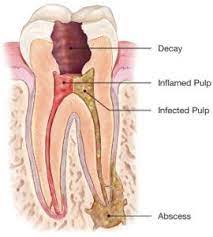What is a detailed description of the root canal process? First we need to know what a root canal is and when one is needed. When a specific tooth decays or becomes infected, a root canal procedure becomes necessary. This process helps relieve the pain a patient is going through while eliminating the infection permanently. If your dentist said you have a root canal, it’s because harmful bacteria has entered the pulp of your tooth. Usually, this happens when an individual neglects a cavity or a chipped tooth due to traumatic injury.
Detailed Description of the Root Canal Process
The process of root canal treatment is relatively straightforward, there aren’t any complications, and with the help of the endodontists, it goes by smoothly. Here’s a detailed description of a root canal procedure.
Area Preparation
Area preparation is necessary for the patient as the endodontist injects local anesthesia into the infected area. Numbing the area ensures the patient doesn’t feel the sting of needles or pain from the procedure. Once they have numbed the area, they place a dental dam in the mouth. This prevents any harmful bacteria from reaching the other teeth while isolating the infected one.
Root Cleanse
Endodontists have advanced tools which they use to drill into the decayed tooth to reach the infected pulp inside. Once they break through the enamel and enter the root canal, they use an antibacterial or antiseptic solution to clean and disinfect the entire area. This kills the harmful bacteria and treats the infection in the tooth.
Giving Shape to the Canals
Before filling the canals with material, they would be shaped accordingly. An endodontist will use their more precise tools to give the canals a proper structure. Once they are shaped, they will be cleaned one more time before the filling begins.
Fill the Canals
Endodontists often use gutta-percha to fill the canals. Gutta-percha is a rubber-like material deposited inside the exposed canals, and then it’s heated and compressed. Heat ensures it fully grips and settles down in the canal, and compression makes sure that it doesn’t leak and provides pressure to alleviate the pain. After this, the endodontist adds adhesives to seal the canal shut. These measures are taken to prevent the bacteria from entering.
Fill Access Hole
The endodontist will now have to seal the drill holes made in the beginning to access the canals. And if the tooth is severely damaged and infected, the endodontist might place a post to keep the tooth steady. They will have to take these extra measures when the tooth is in no condition to support its healing.
Placing the Crown
If the damaged tooth is in the back of the jaw, the patient will have to come back to place the crown. This is for those whose tooth needs the stability and strength a crown provides. After getting the natural-looking crown, the tooth will be strong enough that the patient can chew again.
Recovery Process
Antibiotics play an essential role in the recovery process. The endodontist will prescribe you these antibiotics, and you should take them accordingly. These medications help eliminate the rest of the bacteria and infection. If you receive post-care specifications, you should follow them for a speedy recovery. Also, don’t be alarmed if you feel discomfort after the procedure. A little discomfort is part of recovery; you can take over-the-counter medicines to alleviate the pain.
Description of Root Canal Process: Bottom Line
Now that you know the process of root canal, you can consult our professional endodontist Dr. Young Bui. he is an expert in the field, having performed over 15,000 root canal treatments.
Contact us today for more information and to schedule a appointment.
Young Bui, DDS
30 East 40th Street Suite 1201
New York, NY 10016
646-205-3045
Drendo4u@yahoo.com


